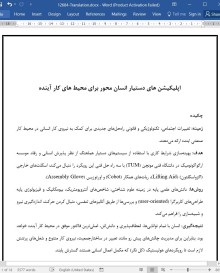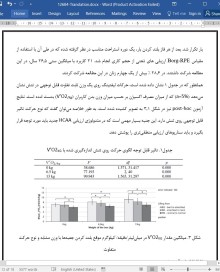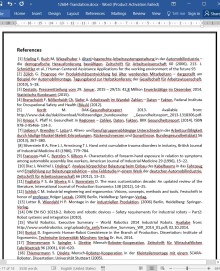
دانلود مقاله اپلیکیشن های دستیار انسان محور برای محیط های کار آینده
چکیده
زمینه: تغییرات اجتماعی، تکنولوژیکی و قانونی راه حل های جدیدی برای کمک به نیروی کار انسانی در محیط کار صنعتی اینده ارائه می دهند.
هدف: بهینه سازی شرایط کاری با استفاده از سیستم های دستیار هماهنگ از نظر پذیرش انسانی و رفاه. موسسه ارگواکونومیک در دانشگاه فنی مونچن (TUM) با سه راه حل فنی این رویکرد را دنبال می کند: اسکلت های خارجی (اگزواسکلتون) (Lifting Aid)، ربات های همکار (Cobot) و اورتوزیس (Assembly Glove).
روش ها: دانش های علمی پایه در زمینه علوم شناختی، شاخص های آنتروپومتریک، بیومکانیک و فیزیولوژی پایه طراحی های کاربرگرا (user-oriented) و بررسی ها از طریق آنالیزهای تنفسی، دنبال کردن حرکت، اندازه گیری نیرو و شبیه سازی را فراهم می کند.
نتیجه گیری: انسان با تمام توانایی ها، انعطاف پذیری و دانش اش، اصلی ترین فاکتور موفق در محیط کار آینده خواهد بود. بنابراین برای مدیریت چالش های پیش رو مانند تغییر در ساختارجمعیت، نیروی کار متنوع و شغل های پرتنش لازم است تا رویکردهای هولیستیک (کل نگر) که مکمل اعمال انسانی هستند گسترش یابند.
1. ایده اپلیکیشن های دستیار انسان محور (HCAA)
1.1. مواجه با چالش های آینده به جای واکنش نیازمند کنش است.
در حال حاضر سه نوآوری اصلی نیاز به بازنگری در محیط های کاری جدید را به پیش می برند. در جایگاه نخست، نقش اصلی جامعه قرار دارد. تغییرات در ساختار جمعیت و افزایش نگرانی ها در مورد نیروی کار متنوع نیازمند اقدام فوری است. به دلیل کاهش توانایی های فیزیکی و شغل های با استرس بالا، راه های ارگونومیک کلاسیک خیلی نمی-توانند کاری از پیش ببرند. بنابراین، توسعه و مدیریت منابع انسانی یکی از بزرگترین چالش های پیشروی سیستم های کاری آینده مانند محیط های تولیدی و لجستیک خواهد بود. کاهش توانایی های فیزیکی و افزایش بیماری های اسکلتی-عضلانی (MSDs) با افزایش سن دلایلی هستند که کار ارگونومیک و غیر مضر برای سلامتی هر فرد را ضروری می سازد. موسسه فدرال ایمنی و سلامت شغلی (BAUA) اعلام کرده است که بیش از 7.6 میلیون کارگر در آلمان (که به طور میانگین 17.8 درصد از کل جمعیت کارگری مقیم آلمان را تشکیل می دهد) مجبور به جابجایی بارهای سنگین هستند. بار سنگین برای زنان بالای 10 کیلوگرم و برای مردان بالای 20 کیلوگرم در کارهای روزمره است. به خصوص در گروه سنی بالای 60 سال، بیماری های MSD یکی از انواع بیماری های حیاتی است که می تواند ناشی از جابجایی مداوم بارهای سنگین باشد. شرکت بیمه DAK-Gesundheit در سال 2013 اعلام کرد که 30.1 درصد از بیماری های اصلی در سنین بالای 60 سال در آلمان MSD است. اما در کارگرانی که در بازه سنی 25 تا 29 سال قرار داشتند میزان MSD ثبت شده تنها 14.6% بود. 25.2 درصد از کل غیبت های شغلی مربوط به MSD است که با ابتلا به ناتوانی شغلی همبستگی دارد. یکی از دلایل ابتلا به بیماری های اسکلتی-عضلانی جابجایی بارهای فیزیکی سنگین به صورت مکرر است. خصوصا در یک مجموعه اتوماتیک، کارها به صورت پیوسته و مونوتونوس است و نیازمند اعمال نیروی بیشتر توسط انسان است و ترکیب آن با سکیل های زمانی کوتاه و کارهای ساده لاجرم باعث افزایش اثرات استرس فیزیکی می شود.
3. نتیجه گیری
چالش های امروزه، مانند تغییرات در ساختار جمعیت، نیروی کار متنوع، اختصاصی انبوه تولید و خودکار شدن تولید، نشان دهنده لزوم بازنگری در سیستم های تولید و لجستیک جدید است. راه حل های ارگونومیک کلاسیک برای حمل بارهای سنگین و فعالیت های مکرر کافی نیستند. اپلیکیشن های دستیار انسان محور باید با حمایت از کارگران برای کاهش تنش های فیزیکی و روانی به حل این معضل را برطرف کنند. با توجه به اینکه فرایندها در محیط کار آینده پیچیده تر می شوند، انعطاف پذیری بیشتر می تواند فاکتور کلیدی برای موفقیت باشد. در زمینه یک عملیات ساده، طبیعی و شهودی، HCAA روی تعامل جامع انسان و فناوری از طریق سطوح مختلف تسلط و تخصیص وظیفه تمرکز دارد. با به کارگیری سیستم های دستیاری، کاهش قابل توجهی در تنش های فیزیکی و روانی اتفاق خواهد افتاد. کاهش
Abstract.
BACKGROUND: Social, technological, and legal changes imply new solutions to support the human worker in the industrial environment of the future.
OBJECTIVE: Optimizing working conditions by adapting collaborative assistance systems in terms of human acceptance and well-being. The Institute of Ergonomics at the Technische Universität München (TUM) follows this approach with three novel technical solutions: Exoskeletons (Lifting Aid), collaborative robots (Cobot), and orthosis (Assembly Glove).
METHODS: Fundamental scientific knowledge in cognition, anthropometrics, biomechanics, and physiology provide the basis for user-oriented designs and investigations via respiratory analysis, motion tracking, force measuring, and simulation.
CONCLUSIONS: The human, with its abilities, flexibility, and knowledge, will still be the key success factor in future working environments. Hence holistic approaches that support the human in a complementary way to raise overall performance have to be evolved to handle upcoming challenges like demographic change, a diverse workforce, and high stress jobs.
1. The concept of Human Centered Assistance Applications (HCAA)
1.1. Facing future challenges requires action instead of reaction
Today, three prime innovation drivers require rethinking in novel working environments. In the first place, there is the main role of the society. Demographic changes and an increasing awareness of a diverse workforce unveil a certain call for action. Classic ergonomic solutions are no longer sufficient because of decreasing physical abilities and high stress jobs [1]. Hence, human resource development and management will be one of the biggest challenges in future working systems like production and logistic environments [2]. Decreasing physical abilities and increasing musculoskeletal disorders (MSDs) with age state reasons for ergonomic, age related, and health preserving work for every person. The Federal Institute for Occupational Safety and Health (BAUA) announced that over 7.6 million employees in Germany, which means 17.8% of the whole employed population (42.85 million people) with residence in Germany [3], have to handle heavy loads. Heavy loads are defined as higher than 10kg for women and higher than 20kg for men, respectively, in their daily work routine [4]. Especially in the age group of over 60 years, MSDs are one crucial type of illness that may result from repetitious handling of heavy loads. The health insurance company DAK-Gesundheit published in 2013 that 30.1% of the main types of illness in the age group over 60 in Germany are MSDs, while in the group of 25–29 year old workers only 14.6% MSDs were recorded [5]. 25.2% of the total absenteeism of work is caused by MSDs [6] and correlates with an untimely entry into occupational disability [7]. One major reason for diseases of the musculoskeletal system is handling high physical loads in a repetitive manner [8]. Especially in automotive assembly, tasks are repetitive, monotonous, and still need high forces applied by the human [9] in combination with shorter cycle times and simplified tasks that inevitably lead to increasing effects of physical stress [10].
3. Conclusion
Today’s challenges, like demographic change, a diverse workforce, mass customization, and automation, call for a rethinking in novel production and logistic facilities. Classic ergonomic solutions are no longer sufficient in handling heavy and repetitive tasks. Human Centered Assistance Applications should close this gap by supporting the human worker to reduce physical as well as cognitive stress. As the processes in future working environments will increase in their complexity, high flexibility could become a key success factor. In the context of a simple, natural, and intuitive operation, HCAAs focus on a comprehensive interaction of human and technology via different levels of dominance and task allocations. By implementing the presented proposal of assistance systems, a significant reduction of physical and cognitive stress can be achieved. Decreasing physical performance because of an older workforce will still be manageable. Handling tasks in difficult and varying situations can especially be performed by anybody and will include mental experiences that improve during a working life.
چکیده
1. ایده اپلیکیشن های دستیار انسان محور (HCAA)
1.1. مواجه با چالش های آینده به جای واکنش نیازمند کنش است.
1.2. تعامل انسان- ربات اساس سیستم های دستیاری جدید
1.3. اپلیکیشن های دستیار انسان محور حمایت روانی و فیزیکی را فراهم می کنند
1.3.1. اگزواسکلتون- Lifting Aid
1.3.2ربات مشارکتی- Cobot
1.3.3 ارتوزیس- Assembly Glove
2. تعامل HCAA از منظر فاکتور انسانی
2.1 مدل تعامل HCAA
2.2 پذیرش و رفاه اپلیکیشن های دستیار جدید
2.3 فاکتورهای تاثیرگذار بر راندمان و رویکردهای روش شناختی
2.3.1 آنالیز تنفسی
2.3.2 اندازه گیری نیرو
2.3.3 دنبال کردن حرکت
3. نتیجه گیری
منابع
Abstract
1. The concept of Human Centered Assistance Applications (HCAA)
1.1. Facing future challenges requires action instead of reaction
1.2. Human-Robot Interaction the basis for novel assistance systems
1.3. Human Centered Assistance Applications offer physical and cognitive support
1.3.1. Exoskeleton – Lifting Aid
1.3.2. Collaborative robot – Cobot
1.3.3. Orthosis – Assembly Glove
2. HCAA Interaction from the human factor perspective
2.1. HCAA Interaction model
2.2. Acceptance & well-being of novel assistance applications
2.3. Performance influencing factors and methodological approaches
2.3.1. Respiratory analysis
2.3.2. Force measuring
2.3.3. Motion tracking
3. Conclusion
References
- اصل مقاله انگلیسی با فرمت ورد (word) با قابلیت ویرایش
- ترجمه فارسی مقاله با فرمت ورد (word) با قابلیت ویرایش، بدون آرم سایت ای ترجمه
- ترجمه فارسی مقاله با فرمت pdf، بدون آرم سایت ای ترجمه



